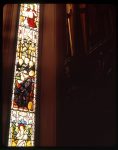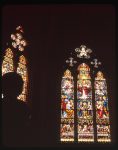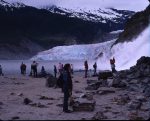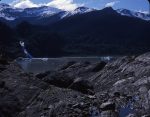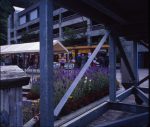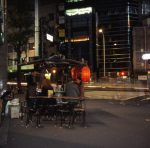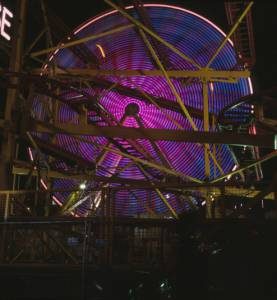 A bit different take on the obvious ferris wheel shot. I was looking for a different image, and I turned around and saw this view. I thought it would be interesting in stereo. f22 8 seconds on Provia 100f film thru my TL120.
A bit different take on the obvious ferris wheel shot. I was looking for a different image, and I turned around and saw this view. I thought it would be interesting in stereo. f22 8 seconds on Provia 100f film thru my TL120.
Category Archives: FolioA
Grand-Staircase Escalante
In April 2018 I went on a road trip to Utah with a few friends. We stayed in the campground in the town of Escalante and went on day hikes to Lower Calf Creek Falls, Escalante River and the Dry Fork Slot Canyons.
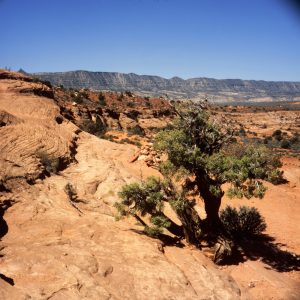 Grand Staircase-Escalante – RDP III – Sputnik (Location) The Grand Staircase-Escalante National Monument was (until recently) the largest National Monument in the contiguous US and comprises enumerable canyons, including some famous ones such as Bryce and Zion. On our first full day, we decided to visit the slot canyons nearby after speaking with the campground owner. I took this slide at the top of the Dry Fork trail which leads down to the slot canyons. |
 Slot Canyons – RDP III – Sputnik (Location) This was taken at the mouth of Peek-a-boo slot canyon. It’s quite high up and it was a bit tricky to get up with my tripod and Sputnik. There wasn’t too much stereo photography that could be done within the slot canyons since the narrow corridor would cause window violations. It’s a really neat place, and I recommend going if you get the chance. The road to get there is like a washboard though, so don’t take a nice new vehicle. Peek-a-boo was the shortest and easiest of the slot canyons here. We also went down Spooky canyon, which was extremely narrow at several points — I couldn’t get through with the backpack. It was also very dark in some places and the sky couldn’t be seen at all. Apparently the third canyon, Brimstone, is even narrower and has pools of water you have to wade through! We ran out of time to attempt it. |
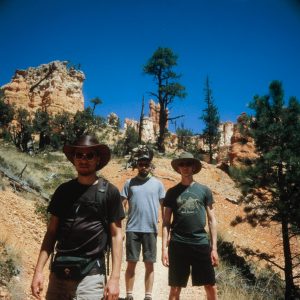 Heroic Hikers – RVP 100 – Sputnik (Location) On our drive back home, we stopped at Bryce canyon and hiked the Fairyland trail. It’s a very beautiful hike. These are my hikineg friends: Gabe, Derek, and Elliot. |
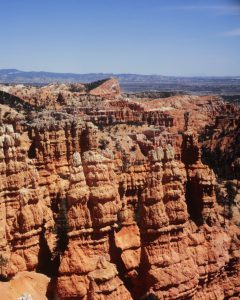 Sinking Ship – RVP 100 – Sputnik (Location) All along the hike, I was wishing I had some sort of twin camera rig, or a bit more time to do some cha-chas. It’s sometimes hard to balance photography with other activities, like hiking with others. I do a lot of walking, so I’m able to take photos and keep up quite well, but it still takes a fair bit of time to stop, set up and level my tripod, meter the scene and take the shot. When we arrived back at our vehicle at Fairyland point, I decided I really ought to take a hyper — cha-cha style. Unfortunately I didn’t have a lens cap or Mike Davis’ spreadsheet, but I found a railing to slide my camera on and I covered one lens with my hand. My apologies for the slightly excessive on-film deviation and corresponding window violation. Otherwise, I’m quite pleased with how it came out. I wish I had taken more hypers, but we had to get going. I hope to come back some day and really take my time shooting. The tilted landmass in the distance is called Boat Mesa or the Sinking Ship. |
Thanks all for sharing your wonderful images. It’s such a pleasure to participate in the folio.
Ian Andvaag
Saskatoon, SK
Go Raptors Go!
Because of the Toronto Raptors historic 2019 NBA Championship win over the Golden State Warriors I have decided to send all my images this round from that fair city. Interiors are Fuji Velvia RVP 100F and exteriors are Provia RDP III taken with the TL 120.
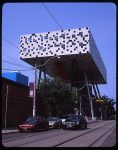 Ontario College of Art And Design It kind of looks like they wanted to preserve the building underneath and stuck this one on top of it.
Ontario College of Art And Design It kind of looks like they wanted to preserve the building underneath and stuck this one on top of it.
Roger’s Toronto Late Afternoon. This is a cha-cha and I got pretty lucky with the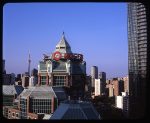 lack of clouds and so not much movement between shutter clicks in the bottom although I just noticed a ladder or small crane in one image and not in the other one. I took a bunch at sunset but they are unviewable because of the cloud movements in the sky. This was taken from the balcony of by brother’s appartement very close to the centre of the city which is basically Yonge and Bloor streets.
lack of clouds and so not much movement between shutter clicks in the bottom although I just noticed a ladder or small crane in one image and not in the other one. I took a bunch at sunset but they are unviewable because of the cloud movements in the sky. This was taken from the balcony of by brother’s appartement very close to the centre of the city which is basically Yonge and Bloor streets.
Stained Glass Silhouette Inside St. James Cathedral on Church Street. Tried to expose for the stained glass windows but maybe a touch too dark.
Scared Arts : Painting, Music and Sculpture. Inside St. James Cathedral on Church Street
Snowmen
I took these slides on the first day of spring, March 21, 2018. For those of you from balmier climes, yes, there can be this much snow in Montreal on the first day of spring. These snowmen had melted a little, and were starting to lose the form and details bestowed initially by their young creators. A couple of them have lost their eyes. Some of their features are starting to look a bit abstract. I initially saw them as somewhat nostalgic relics from the long winter we had been through, perhaps on a smaller time scale the way ruins remind us of a long-gone past, like the statues on Easter Island. My wife found them scary, as though they had escaped from a horror movie, and the more I examined them, the more I could see her point of view. Shot with a Heidoscop on a tripod with Fuji Provia 100F film. Exposures were as follows:
Snowman with a cap and scarf – 1/50th @ f25.
![]()
Snowman with small head – 1/20th @ f25.
![]()
Snowman with scarf and toque – 1/25th @ f25.
![]()
Snowman whose grapefruit eyes fell off – 1/40th @ f25.
![]()
Left and Right
If the Juneau tourists get a bus to the Mendenhall Glacier, a mile long walk along the willows on the lake shore will bring them to the bottom of Nugget Creek. It offers a nice waterfall, and good view of the glacier.We’ve been here before.
And if one walks several miles up the “left” side of the lake, and climbs a little, it is much quieter and less crowded. Not many unguided tourists make it this far up the trail, so when I meet one I try to make them feel welcome. If the lenses in your viewer are good, you can see the crowd of tourists on the beech at the base of the waterfall.
Twenty years ago, all the open water in both images was ice. The face of the glacier was just past the rightmost iceberg in the second image. At that time, the bedrock was below more than 100′ of ice, and Nugget Falls disappeared under the edge of the glacier.
Both images are from my TL120, Nugget Falls has been captured with Kodak E100G rather than my usual Provia.
Town and Tours
Juneau is historically a gold town. More recently, it is a tourist town. On a ‘good’ day, cruise ships can deliver more than 15,000 passengers to shore. And when all those people get ashore, they need to find something to do. Most of the ships work hard to sell package tours on board to their captive audience, but there are still folks on the sidewalks ready to help put tourists on buses out to the glacier or to another dock where they can grab a whale-watch tour.
Most of the vendors are seasonal workers. They arrive from Outside at the start of the season, rent their booth, and sell tours on commission. They’re assertive, but friendly. I’m not often mistaken for a tourist (wrong clothing and not enough tan), but when I am I listen to their pitch before turning them down.
Both of these are from my TL120 on Provia.
Down the Throat
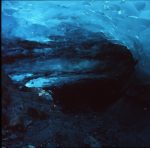 As a bonus image, I’m including a little bit of blue. Like all of my under-glacier images, the light is dim and the location is long gone.
As a bonus image, I’m including a little bit of blue. Like all of my under-glacier images, the light is dim and the location is long gone.
I’m standing in the stream which has cut its way under the ice. The ground is gravel over bedrock, and the deeper one goes the thicker the layer of gravel is. By this point, the gravel is thick enough so the stream is completely contained in the gaps between the stones. The running water carries heat under the ice which creates a gap. Then warm air start to move through and widen the gaps. The color variation in the ceiling is from the variation in thickness and sand content.
I’ve tried several times to try to duplicate this image by print and by film. In call cases, the color reproduction has stymied me. The colors reproduced by the film are not easily obtainable in any of the ink or film-recorder color spaces I’ve tried. I’ll try again in a few more years. Until then, please enjoy this original with all of its subtle colors.
Gi-Me Gelato
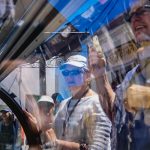
Shot through the side of the Gelato Vendor’s stand, in Rome, I think. It was a quick grab-shot, hoping for the best. Provia 100 – Sputnik.
Atlantis Books
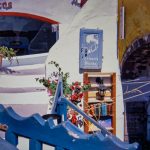
Atlantis Book store on one of the Greek Islands. I must have opened up one stop from Sunny 16 to keep from losing all detail in the shaded store entrance. So, the stark white walls are almost blocked up, but I had to do it -what an amazing scene! I left that Tilley Hat on the airplane, coming home.
Aft-Deck Morn
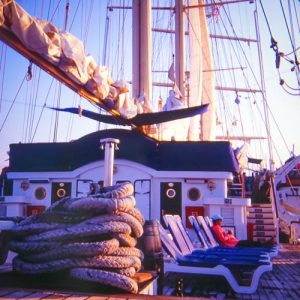
This shot, made early one morning, gives a feel for the atmosphere on the boat. They usually had at least some of the sails up, even when under power. We boarded in Istanbul and sailed/motored to the Islands first, and then on to Corinth and Athens. Our cabin was through those doors behind the rope, and down the stairs. We had a porthole just above the waterline – very peaceful.
I thought this looked a bit saturated for Provia, and sure enough, looking back at the rest of the roll it is RVP100 -Velvia100. I had forgotten that I took any Velvia on the trip, so I mislabeled the view itself. Seems as though Velvia is a good bit “softer” in sharpness than Provia. Consulting the image/data made on my iPhone, using the Pocket Light Meter app,I used 1/60th at f-16.
Sea and Santorini
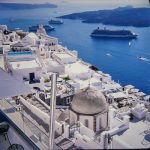
Sea and Santorini
Santorini is one of the Greek Islands we visited during a “Journeys of Paul” tour that Diana and I were on in June of 2017. Our vessel is the sailing craft in the upper left corner of the view, also depicted in Aft-Deck Morn, one of my other views in this round – quite an amazing boat. This was taken with my Sputnik, the only film camera I had on the voyage. Pretty sure I used the Sunny 16 Rule, shooting at 1/125.
Shinjuku Noodle Booth Tokyo
Miracle Mile – Coral Gables Florida
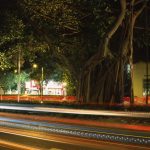 The center island of the Miracle Mile in Coral Gables is lined with these trees. I used a TL-120 on a tripod with a Vivitar 285H fill flash, this was taken after sunset. The fill flash brings out a little touch of detail in the passing cars. I used an incident meter to determine the exposure, hoping to bring out the detail in the trees at the expense of blowing out the store in the background. I think this was a 30 seconds at f22.
The center island of the Miracle Mile in Coral Gables is lined with these trees. I used a TL-120 on a tripod with a Vivitar 285H fill flash, this was taken after sunset. The fill flash brings out a little touch of detail in the passing cars. I used an incident meter to determine the exposure, hoping to bring out the detail in the trees at the expense of blowing out the store in the background. I think this was a 30 seconds at f22.
Infinity Pool – Singapore
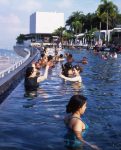 This is the famous Infinity Pool at the top of the Sands three-tower hotel in Singapore. You’ll find a lot of images online of this pool that feature the illusion that the back edge of the water drops off to the Singapore skyline, you’d think swimmers were in danger of falling off. This shot shows why they aren’t.
This is the famous Infinity Pool at the top of the Sands three-tower hotel in Singapore. You’ll find a lot of images online of this pool that feature the illusion that the back edge of the water drops off to the Singapore skyline, you’d think swimmers were in danger of falling off. This shot shows why they aren’t.
May 2018. I used a TL-120 with Provia 100F pushed one stop.
Golden Gate Bridge
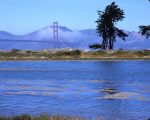 Photographed with twin Mamiya C220 cameras with 135mm lenses. I used Provia 100F pushed one stop. I’m fond of the surreal effect of slightly hyper images taken with zoom lenses. If I take the time to calibrate the twin release cable the Mamiya shutters are easy to sync up. You can see a bird flying in the distance in this shot with no rivalry.
Photographed with twin Mamiya C220 cameras with 135mm lenses. I used Provia 100F pushed one stop. I’m fond of the surreal effect of slightly hyper images taken with zoom lenses. If I take the time to calibrate the twin release cable the Mamiya shutters are easy to sync up. You can see a bird flying in the distance in this shot with no rivalry.
